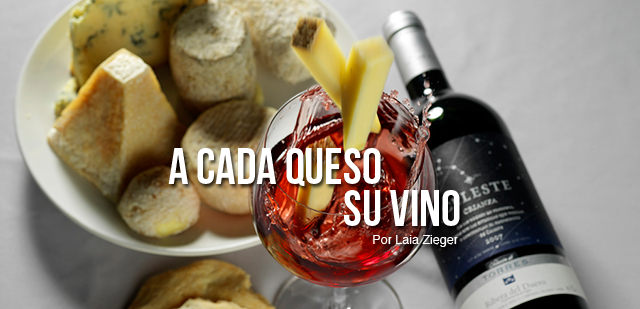A WINE FOR EVERY CHEESE

As a good host, if you want to give your meal a French touch, nothing beats a wine and cheese pairing. It is, however, a risky proposition and requires certain considerations, given the many types of cheese and their different textures, flavors and complexities. It is important to choose the right wine for the right cheese to make sure they go together and support and enhance each other. In other words, they should make a harmonious match.
We've turned to an expert, Luc Talbordet of the Barcelona-based fromagerie Can Luc, to help us navigate this tricky terrain, which demands logical thinking, a savvy palate and a bit of science. He shares his secrets and advice on choosing the right wine for a cheese assortment.
His first piece of advice is to do the tasting in two steps: we begin by tasting our cheese of choice. Chew, savor and swollow. Now we can taste the wine. Then we repeat these steps with the same products, but in reverse: first we taste the wine and then we move on to the cheese. “This allows us to get a true sense of the personality of the wine and the cheese,” Luc says, “After all, both products are equally important and deserve the same consideration.”
He is also a staunch advocate of what many refuse to admit: White wines might be easier to pair with this milk-based product, but a well-chosen red combines perfectly with certain cheeses. The acidity of a white adds freshness and its generally fruity notes balance the distinctive character of the cheese. The right red, however, is a great match, because the cheese's high salt content accentuates the tannins.
He also gives us some general advice, which might save us in a tight spot. Luc recommends we look for a wine with the same geographic origin as the cheese in the pairing. The soil and climate influence the flavor of both products, and their pairing is more likely to succeed if they come from the same place.
We should also remember to keep an even playing field in terms of our tasting components: we shouldn't bring out a Grand Cru unless our cheese platter is equally refined in character. It would be an unforgiveable sacrilege. And finally, as a general rule, keep in mind that the stronger the cheese, the sweeter and more potent the wine should be. By contrast, a milder and fresher cheese calls for a more subtle wine.
Luc's advice is based on the most common pairings of seven big families of cheese, distinguished by their flavor, aromatic and textural characteristics, which in turn are influenced by the type of milk (cow, sheep, goat, etc.); variations in the length of aging; treatments used in their production; salt level and added flavorings (smoked, spices, etc.)
Fresh cheeses
Soft fresh cheeses, which are somewhat salty and have a pronounced milk flavor and acidity (i.e. Burgos, Petit-suisse, mozzarella or ricotta-style cheeses) are usually served with something sweet or savory. This will determine our choice of wine. If served with powdered sugar, jam, fruit coulis or honey, we should go for a sweet and highly aromatic wine, such as a Muscat, Gewürztraminer or Pinot Gris. By contrast, if we serve the cheese with herbs, dried fruit and nuts or salt and pepper, the best choice would be a dry white like a Chardonnay or Sauvignon.
Goat and sheep cheeses
In this family, the density of the paste depends on the length of aging (semi-firm or extra firm). The firmer the cheese, the more intense and saltier its flavor. This category includes, among others, Crottin de Chavignol, Valençay or semi-firm Payoyo. They pair well with slightly fruity, dry or off-dry white wines like Chardonnay or Riesling and light, low-tannin reds like Pinot Noir. Barrel-aged, full-bodied, intense reds are a perfect match for mature sheep cheeses (Manchego or Serra del Tormo, for example).
Soft cheeses with mold-ripened rind
These cheeses have a soft-ripened texture and a somewhat creamy flavor. Here we're talking about Brie and Coulommiers, among others, which are truly sinful pleasures for any cheese lover. They're even more delightful with a glass of red wine that has woodland notes (i.e. Burgundy wines). Keep in mind that the family members known as triple crèmes, such as the exquisite Brillat-Savarin, make for an even better match with high-end cava or Champagne. The bubbles offer a contrast to the cheese's intense cream flavor and “cleanse” the palate of its richly creamy texture.
Soft cheeses with washed rind
This family is characterized by cheeses with very potent flavor and aroma profiles and a creamy texture, such as Munster, Reblochon, Mont d'or or Pont l'évêque. They strike a beautiful chord with very aromatic whites like Gewürztraminers, aged Rieslings or late harvest wines. In the latter case, however, a robust red like Garnacha is a better choice.
Blue cheeses
Fourme d'Ambert, Roquefort, Stilton... When it comes to blue cheeses, the stronger and saltier, the better. These soft, creamy cheeses are a lovely match with a very sweet, luscious wine, either white (Muscat, Sauternes) or red (Port) or even vermouth.
Uncooked pressed cheeses
Cantal, Gouda, Tomme, Mimolette, Morbier... These cheeses have a mild flavor profile and a springy, but compact texture. Opt for a mature Syrah with a mouth-coating, delicate texture and deep, complex aromas, which have developed a fine bouquet.
Laia Zieger
